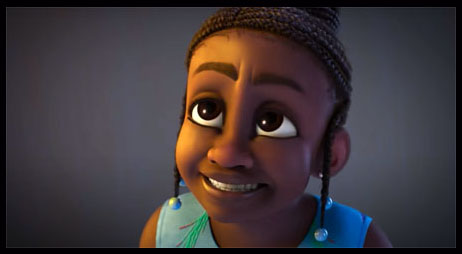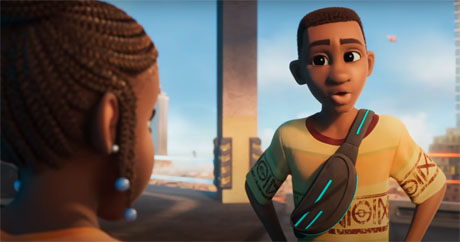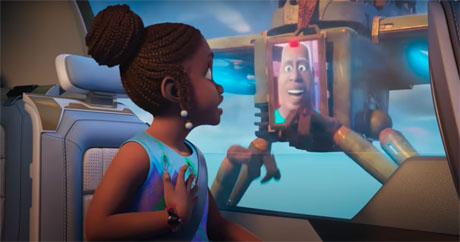
“Iwájú” is a new six-episode animated event series premiering this Wednesday February 28th on Disney+. It’s a collaboration of Walt Disney Animation Studios and African studio Kugali. The story centers on 10-year-old girl Tola and friend Kole in a futuristic Lagos, Nigeria. Crime threatens them and their families. Director and writer Olufikayo Ziki Adeola, production designer Hamid Ibrahim and cultural consultant Tolu Olowofoyeku join me for this Animation Scoop Q&A. (This interview was edited for length and clarity.)
Jackson Murphy: Disney has always focused on strong heroines. Ziki, what do you think are the strengths of 10-year-old Tola, and what did you want to showcase with her?
Olufikayo Ziki Adeola: Tola’s biggest strength is the fact that she’s aspirational. She refuses to accept the world for the way that it is and instead sees the world in the way that it should be. She has the courage to fight for what she believes in. I also like the fact that she has flaws that she needs to overcome. She has the capacity for self-reflection. She realizes her wrongdoings with some of the other characters — she reflects on that and is able to grow as a person.

JM: Hamid, I loved looking at the buildings. How did you study the architecture of Lagos for this series?
Hamid Ibrahim: I went in with a lot of depth. In terms of creating those buildings, there were two thought processes: one was more, “How is it gonna be useful for certain areas?” That’s the mainland — everything has to be as useful as possible because we’re low on space. It’s very crowded. The island was meant to be more at peace. In terms of designing the buildings and the rhythm of the buildings. When I was driving down the streets in Lagos when I went there for research, I was actually physically counting the spaces between buildings — it gives you such a feel of the place. You feel it when you watch it. The mainland ones were meant to be like a pattern. That was the beauty of it. And the island ones are like sculptures — actual physical sculptures people live inside. It’s a very unique feel and look that I wanted to explore.
JM: It is unique. And what were your goals with the central friendship of these two kids — Tola and Kole — and the arc that they go on?
OZA: The purpose of Kole and Tola is to give viewers the opportunity to experience life in the shoes of someone who’s born in the island and has experienced affluence and privilege [Tola] and someone who’s born in the mainland and has had to suffer hardship [Kole]. Ultimately this show is giving people a realistic experience of various lifepaths in Lagos. What’s interesting is that although you have this integration in the sense that they’re in the same household, there’s still this separation because of this societal and cultural divide between the people from the island and the people from the mainland. Their friendship is supposed to explore that nuance. In the beginning, you see that they’re kind of friendly but ultimately Kole is still working for them, so there’s still that separation. But over time they grow closer and are able to bridge that gap and tear down those walls.

JM: You’re creating sophisticated suspense. This is a show about a serious topic: children being kidnapped. Tolu, how did you want to approach that for a family audience?
Tolu Olowofoyeku: There was a very interesting thing that happened in the story creation process. Disney Animation encouraged us to write whatever story we wanted to tell. We knew it was going to be family-friendly because it’s Disney. But they said, “Don’t worry about that at first. Just write the actual story you want to tell.” Once we had the story in place and we knew exactly what things we wanted to tell, then Disney Animation brought that hundred years of experience in telling family accessible stories to help us format the story in a way that’s accessible to children, but adults can still see the core themes.
JM: Absolutely. Hamid, the futuristic aspect of the show is very cool — the technology. At one point Tola is up in the sky and she can buy products in the sky, which is amazing.”Iwájú” means future. What did you want to accomplish with this aspect?
HI: Thank you for bringing up that specific example. The way we built the world of “Iwájú” in terms of showing a futuristic version of Lagos is: we did not want to borrow sci-fi elements from outside and bring them into this world. Flying cars don’t exist in this world because it’s sci-fi, it’s because if you live in Lagos… the traffic is insane and people drive like crazy. If you’re stuck in traffic — and Lagos has some of the most insane traffic you can see anywhere — if you have the money and you can fly over it, you’d definitely [do that]. That creates a challenge. You talk about somebody buying a product in the air. If most of the wealthy people are flying over the traffic now, [the people who are selling items to people in cars on the ground] need to find a creative way to get to them.

Hamid Ibrahim, Olufikayo Ziki Adeola and Tolu Olowofoyeku
TO: Would it surprise you if I told you that in real-life in Lagos in the traffic, you can buy vegetables… a curtain for your house and then a dog?
JM: Wow. I think families are going to love Otin the lizard. Ziki, what does she symbolize for you and for the series? The way you open the show [with her] is a great sequence right out of a Marvel action movie.
OZA: A lot of people really like the character of Otin. When I first came-up with the idea for the story, I wanted Tola to have some kind of protector animal. I wasn’t sure what it was initially. The natural instinct was to go for a dog… but that’s already been done. So instead I thought, “What is a creature that is unique to our part of the world and people would be like, ‘Wow. I haven’t seen something quite like this’?” The Agama lizard, which is native to Nigeria and other parts of West Africa, became a really obvious option. The word ‘Otin’ is named after a protector goddess from mythology and religions. Otin is designed to be a protector. Also, a lizard, she doesn’t really stand out. She represents stealth. And she’s the only member of the main cast that isn’t human. I was very deliberate to try and create a separation between how she would think and behave vs. all the other characters. Oftentimes we like to anthropomorphize. But I wanted her to look at things a little bit strangely. That different lens creates a lot of curiosity on the part of viewers and audiences.

JM: Great character. And Tolu, I want to ask you about your relationship with the folks at Disney and this collaboration — and working with Jennifer Lee. [This is shown] in the hour-long documentary “Iwájú: A Day Ahead”, which is also available on Disney+.
TO: Working with Disney Animation has been an amazing experience. I came to realize that the people that make up Walt Disney Animation Studios are very nice people. All the cheer and love and glee you see in Disney movies is not there because the writer just wrote it in. It’s coming from the people who actually work there. They are very loving people with a genuine love for good storytelling. That made the work easier. You’re working with people that you’re genuinely happy to be around. They have a hundred years of experience, but they didn’t come at this like, “Hey, we’re the experienced guys. We’ll tell you guys what to do.” They came at this like, “What story do you guys want to tell? What do you want to show? Teach us about your culture.” We had a meeting a week where they would just ask me questions. “In Lagos, if people are going to school, how would they do this? How do you buy this or say this?” They wanted to be authentic and learn everything and get it right. The relationship was a very, very good one.
- INTERVIEW: Jeff Fowler On “Knuckles” And “Sonic 3” - April 22, 2024
- INTERVIEW: “Inside Out 2” Director And Producer On Pixar Sequel - April 16, 2024
- INTERVIEW: “Puffin Rock And The New Friends” And 25 Years Of Cartoon Saloon - April 10, 2024


 February 27th, 2024
February 27th, 2024  Jackson Murphy
Jackson Murphy  Posted in
Posted in  Tags:
Tags: 






